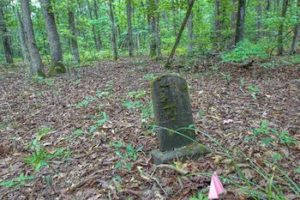
Silver Bluff Cemetery Headstone, South Carolina
*Slave Cemeteries in America are noted on this date in 1760. This is a sacred heritage point for both the Black race and the United States. While researching in eastern Tennessee in 2015, a roadside sign alerted the African American Registry to a historical marker. It was the Wheat Community African Burial Ground, Roane County, TN. The monument, erected in 2000, reads: "This cemetery and memorial is dedicated to the memory of these Africans who were in America in bondage, rather than by choice, and lived. Worked and died in bondage in the Wheat community."
The setting of most of these hallowed grounds is in the Deep South of the United States of America. Yet they exist in all the original thirteen colonies. Africans observed their remembrance of customs brought from the continent. However, disease and death were so common on low country plantations that very few accounts of slave burials exist. Of the hundreds of eighteenth- and nineteenth-century maps and plats, only a tiny handful show the location of slave cemeteries; these serve as a testament to how little these plots of land meant to the enslaved people's masters.
Two examples illustrate the "graveyard" or "burial grounds" in marginal locations, such as next to the water or in low, swampy areas unsuitable for agriculture. They are also poorly defined on the maps and lack roads or passage directly to them. One person, Sam Polite, a formerly enslaved person, explained why so many burials took place at night: "When nigger dead, you can't knock off work for bury'um. You must wait till nighttime to put'um in the grave. You bury 'um by the light of the torch." Another ex-slave, Elijah Green, repeated this observation: "Enslaved people were always buried in the night, as no one could stop to do it in the day. Old boards were used to make the coffin that was blackened with shoe polish."
White owners had little interest in the burials of their slaves, and Blacks seem to have had even less interest in having whites present during this most solemn event. Burial provided an opportunity to provide dignity that was denied during life, and black African beliefs held that the dead would be returning to Africa and a far better life. The headstone of 3-month-old Charlie Burch was the only visible evidence of a burial ground for more than 200 enslaved people hidden beneath an ivy-covered poison field on a hill in Newnan, Ga.
A group of African American women and a society that takes its name from a Confederate Army hero hadn't united to save the site when local officials proposed putting a recreational path through the field. For the first 300 years of the United States, from the tip of Manhattan, New York, to Key West, Florida, on both sides of the Mississippi River, the primary American labor force has buried their dead throughout America.
Prompted by the groups and encouraged by residents' memories of the burial ground, archaeologists and researchers moved in and now believe the site is the largest known slave cemetery in the South. Trees shaded the hill in a residential district with surveying markers and 249 orange flags identifying the likely locations of bodies buried in the field. "A lot of people have always known about it," said Ellen Ehrenhard, an archaeologist and director of the local historical society. However, she said the city planned to build a network of walking trails, including one that would have passed through the cemetery field, that galvanized the groups into action.
City officials have now shelved the plans. "We want the young people here to grow up with a sense of pride in their community and their culture, be they black or white," said Diane Webb. Webb is a member of the Order of Robert E. Lee, the ladies' auxiliary group of the Sons of Confederate Veterans. This Southern heritage organization holds that Confederate leaders fought to preserve "liberty and freedom" in the Civil War.
They are working with a local Black women's heritage group and other organizations to protect the site. "We're all here together. We're one community," Webb stressed. In New Jersey, the Rev. Dr. Wanda Lundy, pastor of Siloam Hope First Presbyterian Church, is collaborating with others to raise awareness about the residents of one of these historic sites. When she became church pastor in the fall of 2019, she discovered the 313 unmarked graves of freed and enslaved parishioners in the cemetery. The resting grounds were used from the 1760s to the 1880s, when the faith house was known as the First Presbyterian Church of Elizabethtown, one of the oldest churches in the state.